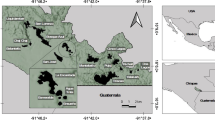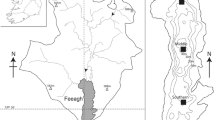Abstract
Sediment cores were taken from near maximum depth in 15 Florida lakes representing a wide range of trophic conditions. Chemical analyses of surface sediments showed Al, Fe, and Ca to be the most abundant elements in all samples, and the ratio of Al to Ca to be smaller for eutrophic lakes. Sediment organic matter increased with trophic state, as did the degree to which it was enriched in nitrogen. Corresponding sediment C/N ratios decreased with increasing lake trophic state and showed significant negative correlation with chlorophylla, total N, and total P in the water column. Concentrations of sedimentary chlorophyll derivatives showed some relation to trophic state but differences in basin morphometry hinder its use as an inter-lake index of chlorophyll production.
Similar content being viewed by others
References
Brezonik, P. L., Morgan, W. H., Shannon, E. E. & Putnam, H. D., 1969. Eutrophication factors in north-central Florida lakes. Univ. Florida Engr. Industr. expt. Sta. Bull. Series No. 134, Gainesville. 101 pp.
Brezonik, P. L., 1976. Trophic classifications and trophic state indices: Rationale, Progress, Prospects. Tech. Rep. Ser. Vol. 2, No. 4, Dept. Environ. Reg., Tallahassee. 45 pp.
Canfield, D. E., Jr., 1981. Chemical and trophic state characteristics of Florida lakes in relation to regional geology. Final Report to Cooperative Fish and Wildlife Research Unit, Univ. Florida, Gainsville, Contract No. 14–16–0009–79–064. 444 pp.
Carlson, R. E., 1977. A trophic state index for lakes. Limnol. Oceanogr. 22: 361–369.
Daley, R. G. & Brown, S. R., 1973. Experimental characteristics of lacustrine chlorophyll diagenesis. I. Physiological and environmental effects. Arch. Hydrobiol. 72: 277–304.
Frink, C. R., 1969. Chemical and mineralogical characteristics of eutrophic lake sediments. Soil Sci. Am. Proc. 33: 369–372.
Gorham, E., Lund, J. W. G., Sanger, J. E. & Dean, W. E., Jr., 1974. Some relationships between algal standing crop, water chemistry, and sediment chemistry in the English lakes. Limnol. Oceanogr. 19: 601–617.
Hutchinson, G. E., 1957. A Treatise on Limnology. I. Geography, Physics, and Chemistry. John Wiley, New York. 1015 pp.
Kemp, A. L. W., 1971. Organic carbon and nitrogen in the surface sediments of Lakes Ontario, Erie, and Huron. J. Sed. Pet. 41: 537–548.
Reddy, M. M., 1977. A preliminary report: nutrients and metals transported by sediments within the Genesee River watershed, New York, U.S.A. In: Golterman, H. L. (Ed.) Interactions between Sediments and Fresh Water, pp. 244–251. Junk, The Hague, and PUDOC, Wageningen.
Shannon, E. E. & Brezonik, P. L., 1972. Eutrophication analysis: a multivariate approach. J. sanit. Eng. Div., Am. Soc. civil Engrs 98: 37–57.
Wetzel, R. G., 1975. Limnology. W. B. Saunders, Philadelphia. 743 pp.
Author information
Authors and Affiliations
Rights and permissions
About this article
Cite this article
Flannery, M.S., Snodgrass, R.D. & Whitmore, T.J. Deepwater sediments and trophic conditions in Florida lakes. Hydrobiologia 91, 597–602 (1982). https://doi.org/10.1007/BF02391974
Issue Date:
DOI: https://doi.org/10.1007/BF02391974




